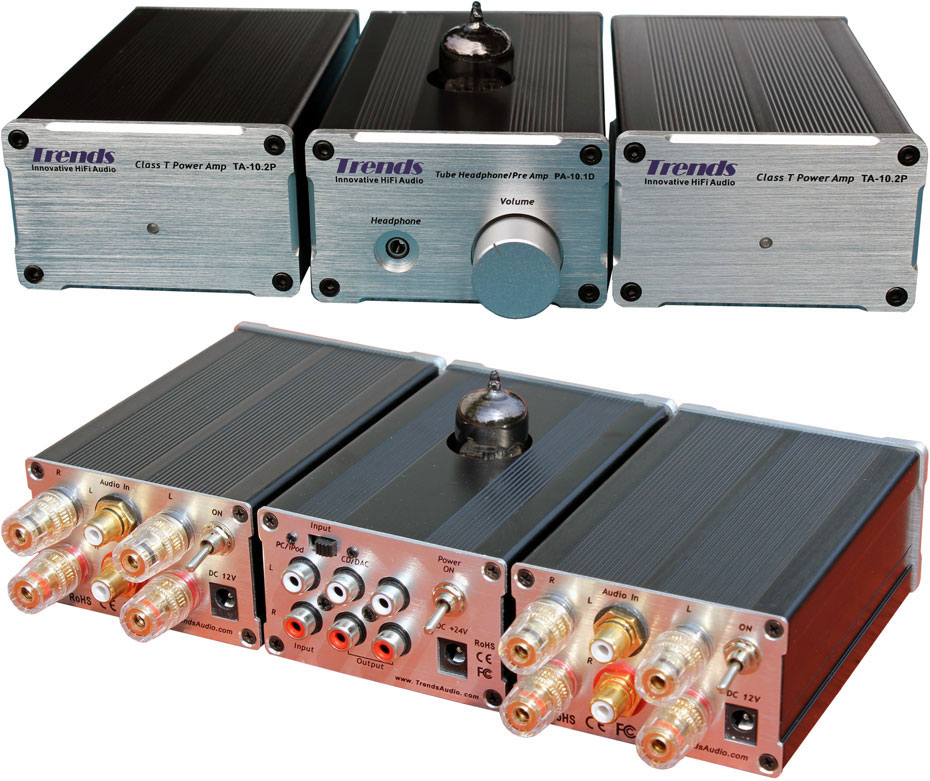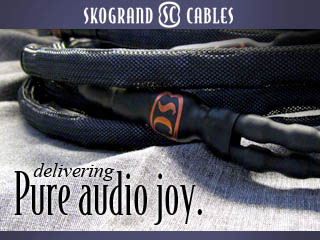
As some of my readers already know, I am interested in and place great value on companies that make complete stereo systems, my reasoning being that listening to a complete system offers better idea of what the company is about. Trends’ approach is to give customers a very compact system for under $1,000; the system provides a tube sound via a tube preamp/headphone amp along with mono-block power amplifiers, and a set of loudspeakers including high quality interconnect cables. Mission one accomplished.
Fortunately, I had the Trends Audio system for roughly four months which is considerably longer than usual, because I was reviewing another system and waiting for other components to break in. This afforded me the opportunity to not only try the system out by itself, but also to test some of the components in other systems.
The system as a whole comes in one large box filled with little boxes. The SR-10 speakers are 2-way designs using a 1-inch polymer dome tweeter with neodymium magnet tweeter and a 5.25-inch multi-fiber coated, pulped paper cone woofer. They are rated 88dB sensitive and specified at 65Hz-22kHz, though no +/1 3dB points were offered. Because I found the low frequency specification to be somewhat optimistic, you will need a subwoofer for fully realized music reproduction. They have good binding posts and the wood finish is a nice touch for this price in that you don’t get the cheap veneers that you normally see from most of the mainstream brands for similar price points.
My one complaint is the speaker grill cloths. I suppose owning Audio Note speakers have made me become used to not dealing with grill cloths. When I removed the grill cloth on one speaker, the plastic plug in the speaker came out along with the grill cloth. This is merely a cosmetic issue and won’t impact sound quality but it doesn’t leave the greatest first impression. To be fair, I have had similar experiences with far more expensive, bigger-name loudspeakers. I found that the SR-10 speakers sound a lot better without the grill cloths in place so I would probably chuck them in the rubbish bin anyway. For whatever reason, the treble response with the grill cloths on sounded grittier.
The PA-10 preamp/headphone amplifier is a superb preamp for the money and I already reviewed it as a headphone amplifier here: https://www.dagogo.com/View-Article.asp?hArticle=522. I did not have the opportunity to review it as preamplifier because I was living abroad and had no system, so it was nice to have the opportunity to finish what I started. My findings surprised me: The PA 10 may be even better as a preamp than as a headphone amp.
Two Class T (known as Tri-path) mono-block amplifiers, the TA 10.2SE, arrived as part of the package, each weighing in at very light 500g (-Approx. 1 lb. -Ed). Each amp comes with a solid external power supply weighing in at 300g. The preamp and mono-block amps are all nicely finished in brushed aluminum, and are well made. The 10.2 amps are rated as 15 watts per channel but it should be noted that this is at 4 ohms. At 8 ohms, Trends rates the power amps as 10 watts per channel and a high 10% THD. However, they also provide specs of 0.1% @ 11W 4ohm and 0.1% @ 6W 8ohm and those numbers decrease significantly at lower wattage outputs. As a SET guy, none of these numbers surprise me in the least, because, most of the time with efficient speakers at normal listening levels, none of these numbers will factor into your listening experience.
This is the second time I’ve auditioned Class T technology and both experiences have been very positive. I remember several years ago the huge buzz surrounding the $30 Sonic Impact class T amp. With a few modifications to the power supply and with the easy-to-drive Audio Note AN K/Spe played at reasonable levels, they bested a number of big name solid-state amplifiers that cost considerably more money. The Trends amps are arguably superior to the upgraded Sonic Impact amplifier, so before you laugh them off based on their price you should be aware that these amplifiers are capable of very pleasing sound for the coin, and escape much of the irritation that comes with high feedback solid-state designs. The provision of course is that you use reasonably efficient speakers – although even here I was surprised at what this amplification could drive.
The QB 773 interconnects were also included. Two sets of these interconnects run $50 for both and are made to be run from the preamp to each mono-block. This is a very reasonable price for such finely built interconnects and also affords a nice aesthetic match for the amplifiers. The CQ500 speaker cables in some quarters are getting very high praise as cable giant killers. The size and quality of construction is very high. Indeed, they’re so solid and weighty that when connected to the power amps they lift the front of the amp a little bit off the floor. I found it rather humorous that the cable is heftier than the amplifiers. I used these cables in systems and never felt a need to change cables or that they were in any way deficient.
Yes but what does it all sound like?
I received this system midway through reviewing a far costlier Roksan Kandy system (https://www.dagogo.com/View-Article.asp?hArticle=1022). After listening to the five times the price Roksan TR-5 speakers and taking the Trends speakers out of the box I was not looking forward to listening to them. My initial impression of the SA-10R speakers directly against the Roksan speakers didn’t have me thinking giant killer. On the other hand, they didn’t make me run screaming from the room. Still, the bigger Roksan speakers have considerably greater bass depth, wonderful treble agility, drive, and ambiance.
It’s unfair, of course, to make direct comparisons to much costlier loudspeakers, but the Trends speakers did seem to possess more treble energy and so with some rock and dance recordings there was more crash on cymbals and seemingly more extension. However, the tweeter isn’t as refined as the Roksan’s ribbon and with less bass response the sound of the SR-10 can be somewhat thin. This improved somewhat sitting farther away from the speakers and toeing them in such that the tweeter crossed a few feet in front of my head.
Removing the Roksan TR-5 from the equation and thinking about other sub-$300 loudspeakers, I feel that the SA-10R will satisfactorily compete with virtually anything I have heard. Certainly the speakers are better than anything I’ve heard for computer-based systems that you will likely find in computer shops. The speakers don’t sound boxy or shut in – they’re really “fast sounding,” clear and open. That can’t be said for many loudspeakers in this price range. They are physically smaller than most mainstream speakers from the likes of Wharfedale, B&W, PSB, Klipsch, or Paradigm. Most of these speakers will not function well on a desk-top, beside a computer, or near walls. So the SA 10R serves real placement restriction needs in that you can place them on a shelf (use some Blu-Tak on the bottom of the speakers to lift them off the shelf slightly) and because they’re so small they will fit most spaces.
The mainstream speakers are quite a bit larger in one or more of their physical measurements and are made to be placed on dedicated stands to sound their best. The Wharfedale Diamond series is a tough stand-mount to beat on sound quality at the price and has a clear edge in terms of bass response, and a more coherent sound from top to bottom than the SR-10. The Wharfedale speakers do cost about $100 more and again are considerably bigger speakers that won’t fit well on a desk top.
As previously mentioned, I was afforded the opportunity to try the PA-10 preamp and 10SE power amps on other speakers including the Roksan TR-5 and Audio Note AX-Two stand-mounts. The Roksan amplifier is rated well over 100watts per channel but the TR-5 speakers are not all that difficult to drive despite their average 87dB sensitivity. Interestingly, the Trends amps not only held their own against the Kandy but in some respects sounded better. Don’t get too excited – the Roksan Kandy still put out a bigger left-to-right soundstage and had a tighter grip to bass frequencies at higher sound levels. Nevertheless, the Trends amps have a richer sound and more depth to the sound stage and a little more decay on piano on “The Pretender” from Jackson Browne’s Live Acoustic Vo.l 1 CD. Vocals via the Trends Audio class T had less sibilance than with the Kandy. The Kandy sounds bigger, creates more air around instruments, can handle bigger scale music than the Trends amps can with the TR-5 speakers. The Trends amps had richer tonality and more body and the dreaded audiophile term – more “organic” presence and ambiance.
- (Page 1 of 2)
- Next page →



More information about the Trends CQ-500 OCC speaker cables will be appreciated. AWG, Geometry, Shielding, Cross-section picture, Measurements – Resistance, Inductance and capacitance, etc? Nothing much available on the web, including the manufacturer’s website,